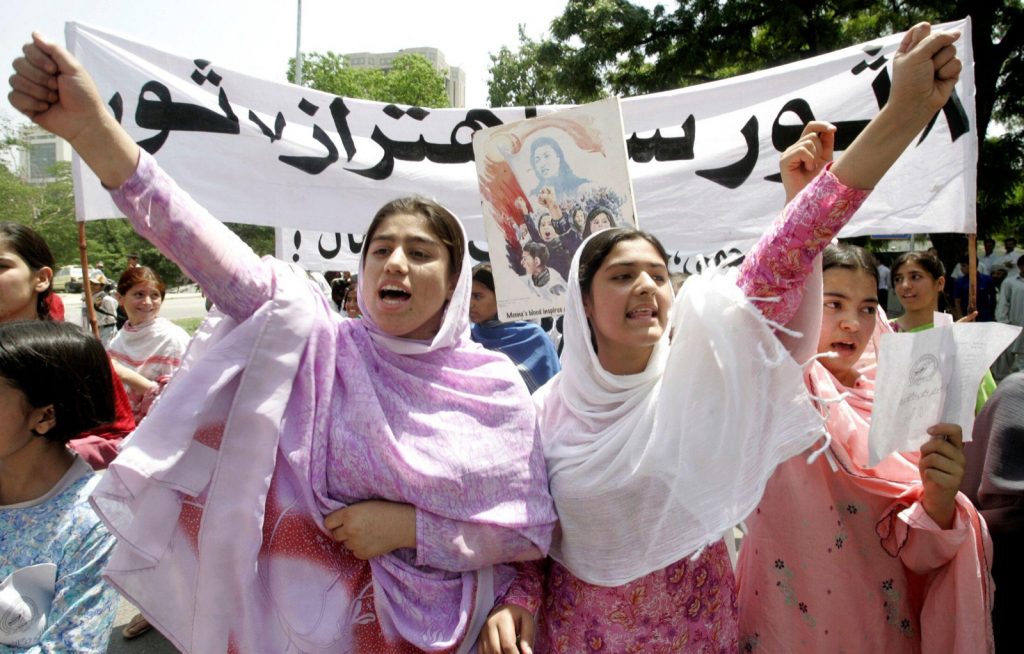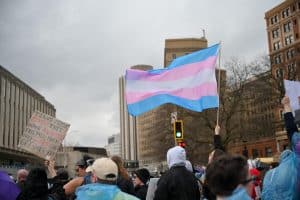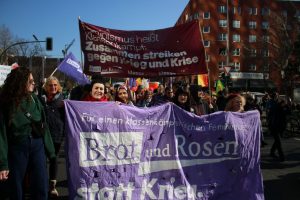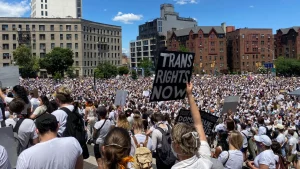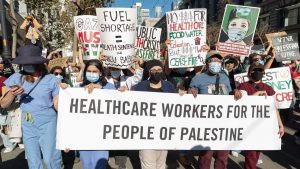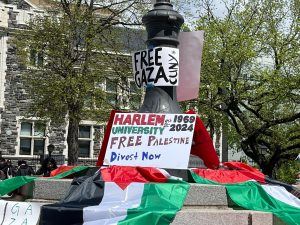This article is the second in a Left Voice series on the situation of women in Afghanistan and the tasks of the international feminist movement in the fight against gender oppression. The return of Taliban rule in Afghanistan promises, and in many areas has already imposed, a rollback of women’s political, economic, and social rights that were hard-won by the Afghan feminist movement.
The plight of Afghan women and children has long been exploited as an excuse for foreign intervention in the country. These same arguments are being trotted out today to justify a continued U.S. presence, despite the official withdrawal of U.S. troops from the country. The dire conditions women Afghan women face today under brutal Taliban control are in fact the result of U.S. imperialism, as well as religious fundamentalism and civil war. They stem from an imperialist system built on the exploitation of the vast majority for the profit of a few.
There is an urgent need to adopt an anti-imperialist perspective as part of fighting back against the reactionary measures of the Taliban and winning the liberation of all women from the yoke of capitalist exploitation and oppression. From a socialist feminist perspective, the articles in this series take up the question of imperialism and liberal feminism and the history of the feminist movement in Afghanistan, and debate other strains of anti-imperialist feminism.
***
Part 1 | Part 2 | Part 3
A century into so-called political sovereignty, the social, political, and economic development of Afghanistan is far from complete. Caught between competing imperialist powers, Afghanistan has long been essential for winning hegemony over the rest of central Asia. Forty years of successive wars — and decades of imperialist economic relations before that — has maintained Afghanistan as a dependent state, to the detriment of the Afghan masses. While women have, on paper, won crucial rights, they are far from being a lived reality for most women in the country. Now, as the Taliban takes over political leadership from the latest puppet regime imposed to do U.S. imperialism’s bidding in the midst of decades of brutal war, and plunges the masses into an era of conservatism and Islamic fundamentalism, the fight for social, economic, and democratic transformation becomes even more dire.
But this is not a fight foreign to Afghans.
Contrary to the claims of bourgeois historians, demands for social reforms in Afghanistan — including for women’s rights — predate both the U.S. and Soviet occupations. Reforms in Afghanistan have never been simply a project of occupying powers aiming to bring a conservative, “backward” country into modernity and an age of secularism, industrialism, and liberalization; in the 20th century, they have been deeply tied to the question of nation-building by and for Afghans themselves.
Conquest of Reforms in the 20th Century
Much of Afghanistan’s history is a direct result of waves of class struggle over the last century as the Afghan masses faced the question of their own national development and their country’s social, political, and economic transformation. The most notable of these were the uprisings that erupted at the end of World War I and those that took place through the decade of the 1960s. While a product of Afghanistan’s unique social and political circumstances, these uprisings were also a part and product of international class struggle that marked each of those historical moments.
The success of the Russian Revolution in 1917 and the conclusion of World War I saw the growth of revolutionary processes around the world, particularly in the Global South where the struggle for independence from colonial control gained new life. This global process found an echo in Afghanistan where demands for social reforms had been brewing for decades, especially within the country’s own struggle against British imperialism.
The Young Turk movement had spread like wildfire across the Ottoman Empire in the early 20th century and had a profound influence on the rest of the Islamic world. A largely nationalist movement led by liberal intellectuals, the Young Turks demanded the dismantling of the autocracy and the creation of a constitutional democracy that removed religion as a part of the state.
This movement for democratic rights gained new ground in Afghanistan, where radicals who had been fighting against British imperialist rule and autocracy took up the same demands. Following the Anglo-Soviet peace treaty of 1919 that freed Afghanistan from direct British control, the calls for national transformation became more pressing, culminating in Afghanistan’s first constitution in 1923. Crafted under the reign of Amanullah Khan and his wife, Queen Soraya (both influenced by the “Young Afghans”), it included significant reforms across the social sphere, particularly for women — including unveiling, access to education, raising the legal age for marriage, and equal rights for men and women. The constitution also abolished slavery and forced labor, established an independent court system, and issued new civil, commercial, and penal codes that included outlawing the exchange of women as “blood money” in intra-familial disputes.
Alongside these reforms, however, imperialism maintained its influence. European capital investment built palaces, government buildings, trolley lines, theaters, and cafes in the cities, designed by European architects. Meanwhile, the rural masses — the majority of the population — were left behind in this era of modernization and crushed under increasing taxation. The subsequent conservative backlash would force Amanullah to abdicate in 1929. But this could not erase the demands for reform that had birthed the movement, and which has continued in the decades since.
The demands for change, especially after World War II, not only pushed the state to implement some democratic structures, but also restored women’s right to unveil, their access to higher education, and the right to vote and participate in the economy and politics. Government and industry job guarantees sent much of the youth flooding to the universities in pursuit of higher education. But a lack of industrial progress and dependence on foreign aid significantly reduced these opportunities, especially for those from working-class backgrounds. They found themselves not only unemployed, but also with little to no connection to the traditionalism of their parents, and were increasingly drawn to radical ideologies, especially communism, as a solution. University student protests became increasingly frequent.
In 1968, revolutionary processes gripped the world, with protests and strike waves threatening the capitalist order. In Afghanistan, student demonstrations escalated — often in support of industrial strikes, many of which were led by communists. Women continued to protest for social gains, too, but also against conservative backlash and violent misogyny. In 1970, protests by thousands of women forced the state to jail radical Islamists who were attacking women with acid on the streets.
The Afghan state, however, tied to imperialism and tremendously dependent on foreign aid for national development, lacked the capacity to alleviate the economic and social tensions within the country. Seeking to impose civil order and contain the burgeoning anger of the masses, Mohammed Daoud Khan, a former prime minister and military general, staged a coup to replace the monarchy in the name of democracy — but eventually transformed Afghanistan into a military dictatorship.
The motors of revolution were still turning around the world, though, and political transformation in Afghanistan was not far behind. The Iranian Revolution that began in 1978, in particular, had a profound impact on the rest of the Islamic world, where the clamors for social change were increasing exponentially. In Afghanistan, a small band of communists ousted the Daoud regime and began its own period of change.
Forty Years of Invasion
Although the Stalinist People’s Democratic Party of Afghanistan (PDPA) eventually took state power, it was unable to generate consensus among the masses. The new government quickly imposed a program of radical reform, including cancellation of debt for landless farmers, collectivization of agriculture, the advancement of women’s rights and literacy campaigns. Change, however, came not through the revolutionary action and self-organization of the masses, but was imposed through decrees and by unleashing the repressive apparatus of the state against all detractors of the PDPA, whether on the left or the right.
In the face of growing armed resistance from the countryside against the forced modernization and repression, especially from ethnic tribes, the PDPA would eventually welcome an invasion by the Soviet Union. That marked the beginning of 40 years of military occupation and war, the effects of which are especially pressing today.
Occupying forces — first the Soviet Union and then the United States — attempted to impose crucial social reforms, especially in the realm of women’s rights. It was almost inevitable that foreign armed forces imposing these reforms would generate the conservative backlash that followed, especially from a rural, traditionalist population that came to view the reforms as tools of imperialism.
The United States had funded these same traditionalist forces in their fight against the Soviet Union, ultimately paving the way for Taliban rule through the 1990s — which ushered in one of Afghanistan’s most reactionary regimes of the 20th century, especially for women.
Women were not passive through these decades of military invasion, repression, and conservatism. They actively fought for their rights. Even in the face of the most reactionary manifestations of imperialism and patriarchy, women organized themselves and fought back. The Revolutionary Association of the Women in Afghanistan (RAWA), one of the most notable organizations in the fight for women’s rights in Afghanistan today, is also one of the country’s oldest women’s organizations fighting for social justice, freedom, and secularism.
Founded in 1977 by female university students in Kabul, RAWA reflected the fight for women’s rights that had grown over the decades in the country. (One of RAWA’s founders, Meena, was later assassinated by Soviet agents at age 30.) Formed in the years of Soviet influence and subsequent invasion, RAWA’s fight for justice and human rights continued under the fundamentalist regimes and during the U.S. invasion and occupation. Since the beginning of the “war on terror,” RAWA has not only fiercely opposed U.S. imperialism, but has fought against both Islamic fundamentalism and the Northern Alliance, which acts as a puppet for the United States in the north of the country. Today, RAWA correctly recognizes U.S. imperialism as one of the main causes of social degeneration and misery in Afghanistan, especially for women. For the women of RAWA, the path to the emancipation of Afghan women is the path of revolution and active resistance against imperialism and its agents. As Samia Walid, an activist in RAWA notes in an interview with Kurdistan Report,
We see the liberation of Afghan women in their liberation from imperialist colonizer(s), Islamic fundamentalists and the puppet government. The freedom of women is directly tied to the resistance and revolutionary struggle of women against the main cause of their suffering and misfortune, meaning occupiers and their internal lackeys. We believe that fundamentalists and murderous and corrupt groups involved in killing, looting and other crimes and treacheries have no source of support except for foreign powers, without which they would not survive a day.
The Current State of Afghanistan’s Economy
While women, workers, and radical youth in Afghanistan throughout the 20th century struggled for and won some democratic and social rights, these movements — and the reforms won on their backs — had severe limits. The intellectuals and liberal petit bourgeois leaders of the reform movements had a clear program for those in urban centers such as Kabul, they did little to bridge the gap with the rural masses steeped in poverty, still backward socially and economically, and under the leadership of conservative tribes and warlords who continued to impose severe restrictions on women. None of these reform movements sought alliances with the peasant masses to change the material conditions that could create the foundation for a social transformation, erroneously believing that what happens in the cities will eventually reach the entire country..
This urban–rural divide characterized the waves of reforms and subsequent conservative backlash, continuing to this day. The rural masses are not some insignificant minority, but are the vast majority — nearly 75 percent — of Afghanistan’s population. The conservatism that continues to characterize their lives, their outlook, and much of the course of social reforms is the direct product of the failures of capitalism.
More than 40 years of near consecutive war since the beginning of the Soviet invasion in 1979 has wrought profound devastation on the Afghan economy, but the lack of economic and human development has a much longer history. While five-year plans developed roads, infrastructure, education, and services in the cities and turned Kabul into a modern hub, the countryside still lags behind. There has never been a national program to modernize agriculture to improve the conditions of the agrarian class, nor sufficient industrial growth that could help such modernization. Without it, subsistence agriculture persists, with little surplus for distribution. Farmers are highly susceptible to extreme weather conditions, especially devastating droughts that have led to famines. Today, most of the countryside continues to live in poverty, with one-in four people living in abject poverty. Budgets allocated to local warlords go toward limited localized and decentralized development — when not used by the warlords to line the pockets of their allies — and do nothing to bridge the relative isolation of the different ethnic tribes that make up the country.
Afghanistan’s lack of industrial development and modernization is directly tied to the strategic role the country has played for world capitalism. For more than a century, Afghanistan has represented for imperialist powers a key to establishing control and hegemony over central Asia. What began as the “Great Game” between the British and he Russian empires through the 19th- and early 20th centuries continued even after Afghanistan gained sovereignty, first through soft alliances and then through active military intervention.
Much of Afghanistan’s development was defined by the Cold War between the Soviet Union and the United States following the conclusion of World War II. In the U.S–Soviet competition for political hegemony, Afghanistan became a major recipient of aid from both countries. Beginning in the 1950s, development was largely fueled by international financial aid, with foreign sources providing an average of 75 percent of the capital for five-year plans between 1956 and 1972. By 1973, foreign investments were providing nearly two-thirds of the state’s revenue. These investments, of course, came with conditions: they were not put to the task of the centralized planning and development of the Afghan economy, but to the geostrategic priorities of donor nations. Since the beginning of the decades-long wars, this dependence on foreign aid has become more acute, as the little industry in the country has been destroyed by successive military occupations. Over the last 20 years, the Afghan economy has been singularly fueled by international aid: some $404 million in 2002–03; and $15.7 billion in 2010–11, which was almost all of Afghanistan’s GDP that year. By 2020, foreign investment constituted 42.9 percent of Afghanistan’s GDP. This change, however, isn’t based on the development of the economy and infrastructure, but on the fall in foreign aid as the Taliban gained more territories. As during the Cold War, Afghanistan continues to be a rentier state.
Where Do Women’s Rights Stand?
Capitalist exploitation is at the heart of gender oppression. In Afghanistan, capitalism has been directly responsible for a growing rural–urban divide that keeps the masses steeped in traditionalism and patriarchy. Women in cities, especially those among the bourgeoisie and petit bourgeoisie, have benefited tremendously in successive waves of reform and foreign aid. They’ve been able to educate themselves, unveil, and enter social and political life, made possible by the “aid” work of NGOs that act as agents of imperialism and maintain Afghanistan’s dependence. As Walid from RAWA notes,
NGOs are a major part of the backbone of imperialism in our country. NGO-ization, we believe, is almost as dangerous as the formation of the puppet government of Afghanistan. The NGOs formed in Afghanistan are almost all through the funding of the US and other Western powers. They are a hotbed for recruiting youth to form the future puppet governments of Afghanistan which will have the appearance of a modern, democratic government, but whose heads will be brainwashed to serve as much more loyal lackeys of these powers. NGOs are also used to suck out nationalism and revolutionary struggle out of the heads of our youth by giving them huge salaries and lives abroad.
Indeed, the Afghan constitution claims to be one of the most “progressive” constitutions in the world, highlighting guarantees for women. Before the Taliban’s takeover, women made up 30 percent of the government. Yet, most women continue to face discrimination and violence in everyday life. While some women in the cities are able to reap the benefits of the constitutional reforms, the majority of rural and working women continue to live in poverty and are bound by traditionalism. Women may have won the war on paper, but the fact that material conditions for the working and rural masses have not improved is a real obstacle that deepens the oppression of women across Afghanistan.
Women are not only forced into social reproduction labor, but like many young Afghan children, are often forced into work for little to no money for the benefit of the family. In poorer families, women are often married off at a young age to ease the financial burden. Furthermore, in the face of crippling poverty, tradition and kinship provide social and economic comfort. In Afghanistan, this manifests in the doubling down on Islamic conservatism and patriarchy and the rejection of individualism, and, along with it, women’s rights, which are seen as antithetical to Islam and the traditional way of life. Women in the war-torn countryside face further obstacles in that the armed conflict restricts their freedom of movement, and they often must rely on the security offered by their male escorts in public.
The Fight Against Gender Oppression is the Fight Against Capitalism
These women are not simply passive victims of oppression. They make society run. In the pre-war era as today, much of rural society was kin-based, with a broad division of labor. In addition to tasks of social reproduction such as child care, cooking, and household financial management, women play a central role in the fields, prepping the soil for the season, tilling the land, and harvesting crops. Women are also the traditional creators of Afghanistan’s famous rugs and handicrafts. They increasingly participate in livestock production and dairy processing. Yet, much of this labor and participation in the economy remains invisible, as women are rarely, if ever, paid for their labor. When women are paid, their wages are a fraction of what men receive.
Traditional gender roles constrain women’s mobility. The inability of women who make handicrafts to go to bazaars and sell their goods directly means they must rely on their male family members or other middlemen for final sale. Despite their invisibility, rural and working women play an outsized role in Afghanistan’s economy. As Benard et al., note in their book, Women and Nation Building 1Bernard, Cheryl, et al. “Economic Participation and Women.” Women and Nation-Building, RAND Corporation, 2008, pp. 81–93.,
Taken in sum, all of this “traditional” female economic activity, paid or bartered, is probably more valuable than it may seem. In Afghanistan’s highly informal economy, with 80 to 90 percent of activity estimated to be in the black or gray economies, barter and nonmonetized work become very important. And, although women are precluded from selling products at market, they are able to trade items such as handicrafts or the eggs from their chickens in their villages. However, this sort of value, while contributing to Afghanistan’s overall economy, does not contribute proportionately to the required effort to the benefit of the women themselves or their households.
In Afghanistan, as in much of the world, patriarchy and capitalism thus meld to maintain the continued exploitation and oppression of women. Making little to no pay — justified as “tradition” — rural and working women are a crucial workforce that keeps society running. Their exploited labor — be it social reproduction work or other work — contributes to the continued precarization of the Afghan working class as a whole. The equality bourgeois law promises women has not meant an equality in life. The fight for women’s rights, therefore, cannot be separated from the material oppression the majority of women face under capitalism, which uses all the tools available to it, including “tradition,” to maintain the precarization of women.
The women of RAWA state that it is only through a revolutionary struggle against imperialism, fundamentalism, and their national allies that women’s emancipation, justice, and democracy are possible. This is true. But as the last hundred years of imperialist influence and domination have shown, the issue of democratic rights is inseparable from class oppression. The rural and working women of Afghanistan, who face the dual oppression of gender and class, have little in common with urban bourgeois women who have enriched themselves over the decades by allying with capitalist interests. For the women of Afghanistan to overthrow the yoke of patriarchy, it is crucial not only to fight against imperialism but also against their own national bourgeoisie, which maintains class oppression for its own ends, and take the path of socialist revolution.
Notes
| ↑1 | Bernard, Cheryl, et al. “Economic Participation and Women.” Women and Nation-Building, RAND Corporation, 2008, pp. 81–93. |
|---|


